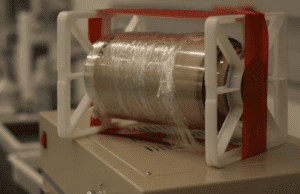Hydrogen fuel cells and electrolyzers will be crucial technologies as the global energy transition progresses. However, both devices are often hampered by issues with durability and material costs — mainly associated with their membrane elements — which have slowed their widespread adoption. Now, a material-science breakthrough developed by Celadyne Technologies Inc. (Chicago, Ill.; www.celadynetech.com) has led to an alternative membrane technology called Dura, which is both more durable and efficient than the conventional proton-exchange membranes (PEMs) that are the heart of many fuel cells and electrolyzers.
“Current fuel cells struggle with durability because hydrogen crossover inadvertently causes side reactions that lead to degradation of the membrane, catalyst layer and other components. Dura is the first-ever low-permeability, bilayer PEM that is durable, chemically impermeable and conductive,” says Gary Ong, CEO and founder of Celadyne Technologies. Creating such a membrane required marrying two very different materials into a composite that reduces gas permeation across the membrane while retaining high conductivity and stability to enable thinner membranes with overall lower membrane resistance. “We built upon developments in hydrocarbon chemistries that were developed for fuel cells while combining this understanding with how composites are made at the micro- and nano-meter scales.

Durable materials are crucial for advancing the application of fuel cells and electrolyzers (image source: Celadyne)
“Dura cuts down on hydrogen crossover by more than 50% to address the root cause of free-radical formation in fuel cells while enhancing electrolyzer safety, especially at high pressures and low current densities,” says Ong. Also, when compared to traditional PEM membranes, Dura’s fabrication reduces the usage of per- and poly-fluoroalkyl substances (PFAS) by around 60%.
Celadyne Technologies has worked with the U.S. Air Force (Washington, D.C.; www.af.mil) to operate a demonstration-scale 100-W fuel cell, and the company is also collaborating with partners to explore the deployment of its technologies into heavy-duty trucking, wastewater treatment plants and other industrial applications.